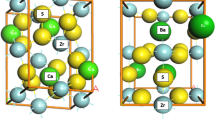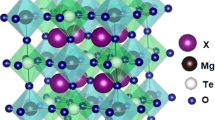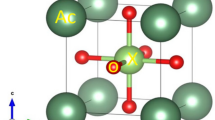Abstract
The α- andc-axis thermal expansion coefficients of α-Zn2V2O7 (monoclinic structure) were found to be negative between 20 and 560‡C. The volume expansion coefficient is negative above 260‡C. As a result, the zinc atoms tend to be in sixfold rather than fivefold coordination. Similar behavior results from substitution of larger sized ions on Zn sites. These effects are associated with the shear strain suffered by the soft Zn-0 polyhedra as a result of significant changes in Β. On cooling from 20‡C to liquid-nitrogen temperature, as well as upon substitution of smaller sized ions on Zn sites, the major structural changes occur along theb axis, without changes in theac plane: the soft polyhedra experience uniform compression and the Zn ions remain in fivefold coordination. Only in the latter case is the extent of substitutional solid solutions governed by the relative difference in size between the host and substituent ion.
Similar content being viewed by others
References
Filatov, S.K.,Vysokotemperaturnaya kristallografiya (High-Temperature Crystallography), Leningrad: Nedra, 1990.
Zabara, O.A., Krasnenko, T.I. and Fotiev, A.A., Chemical and Thermal Strains in Divalent-Metal Metavanadates,Neorg. Mater., 1992, vol. 28, no. 8, pp. 1744–1748.
Zhuravlev, V.D., Velikodnyi, Yu.A. and Surat, L.L., X-ray Diffraction Study of the Systems Mn2V2O7-M2V2O7 (M = Ba, Sr, Ca, Co, Zn, Cu, Ni),Zh. Neorg. Khim., 1993, vol. 38, no. 7, pp. 1221–1224.
Fotiev, A.A., Trunov, V.K. and Zhuravlev, V.D.,Vanadaty dvukhvalentnykh metallov (Divalent-Metal Vanadates), Moscow: Nauka, 1985.
Nord, A.G. and Stefanidis, T., Crystal Chemistry of α-(Zn, M)2V2O7 Solid Solutions: Correlation between Preference for Five-Coordination and Extension of Solid Solubility,Mater. Res. Bull., 1985, vol. 20, no. 7, pp. 845–851.
Andrianova, L.V. and Filatov, S.K., Algorithm and Program for Computing the Principal Components and Axes of the Thermal, Baric, and Chemical Strain Tensors of Crystals,Appar. Metody Rentgenovskogo Anal, 1984, no. 32, pp. 88–93.
Gopal, R. and Calvo, C., Crystal Structure of α-Zn2V2O7,Can. J. Chem, 1973, vol. 51, no. 7, pp. 1004–1009.
Zolotukhina, L.V., Krasnenko, T.I., Zabara, O.A., and Zabolotskaya, E.V., Structural and Magnetic Properties of Ca1-xMnx(VO3)2,Zh. Neorg. Khim., 1996, vol. 41, no. 2, pp. 202–205.
Author information
Authors and Affiliations
Rights and permissions
About this article
Cite this article
Krasnenko, T.I., Zolotukhina, L.V. & Andrianova, L.V. Thermal strain in zinc pyrovanadate. Inorg Mater 36, 1032–1035 (2000). https://doi.org/10.1007/BF02757980
Received:
Revised:
Issue Date:
DOI: https://doi.org/10.1007/BF02757980




